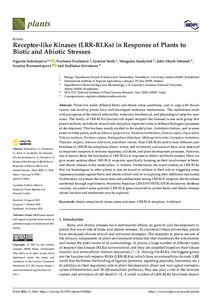| dc.contributor.author | Soltabayeva, A. |
| dc.contributor.author | Dauletova, N. |
| dc.contributor.author | Serik, S. |
| dc.contributor.author | Sandybek, M. |
| dc.contributor.author | Omondi, J.O. |
| dc.contributor.author | Kurmanbayeva, A. |
| dc.contributor.author | Srivastava, S. |
| dc.date.accessioned | 2022-12-02T08:03:49Z |
| dc.date.available | 2022-12-02T08:03:49Z |
| dc.date.issued | 2022 |
| dc.identifier.citation | Soltabayeva, A., Dauletova, N., Serik, S., Sandybek, M., Omondi, J. O., Kurmanbayeva, A., & Srivastava, S. (2022). Receptor-like Kinases (LRR-RLKs) in response of plants to biotic and abiotic stresses. Plants, 11(19): 2660, 1-20. |
| dc.identifier.issn | 2223-7747 |
| dc.identifier.uri | https://hdl.handle.net/20.500.12478/7951 |
| dc.description.abstract | Plants live under different biotic and abiotic stress conditions, and, to cope with the adversity and severity, plants have well-developed resistance mechanisms. The mechanism starts with perception of the stimuli followed by molecular, biochemical, and physiological adaptive measures. The family of LRR-RLKs (leucine-rich repeat receptor-like kinases) is one such group that perceives biotic and abiotic stimuli and also plays important roles in different biological processes of development. This has been mostly studied in the model plant, Arabidopsis thaliana, and to some extent in other plants, such as Solanum lycopersicum, Nicotiana benthamiana, Brassica napus, Oryza sativa, Triticum aestivum, Hordeum vulgare, Brachypodium distachyon, Medicago truncatula, Gossypium barbadense, Phaseolus vulgaris, Solanum tuberosum, and Malus robusta. Most LRR-RLKs tend to form different combinations of LRR-RLKs-complexes (dimer, trimer, and tetramers), and some of them were observed as important receptors in immune responses, cell death, and plant development processes. However, less is known about the function(s) of LRR-RLKs in response to abiotic and biotic stresses. Here, we give recent updates about LRR-RLK receptors, specifically focusing on their involvement in biotic and abiotic stresses in the model plant, A. thaliana. Furthermore, the recent studies on LRR-RLKs that are homologous in other plants is also reviewed in relation to their role in triggering stress response processes against biotic and abiotic stimuli and/or in exploring their additional function(s). Furthermore, we present the interactions and combinations among LRR-RLK receptors that have been confirmed through experiments. Moreover, based on GENEINVESTIGATOR microarray database analysis, we predict some potential LRR-RLK genes involved in certain biotic and abiotic stresses whose function and mechanism may be explored. |
| dc.description.sponsorship | Nazarbayev University |
| dc.format.extent | 1-20 |
| dc.language.iso | en |
| dc.subject | Abiotic Stress |
| dc.subject | Biotic Stress |
| dc.subject | Stress |
| dc.subject | Tolerance |
| dc.subject | Arabidopsis |
| dc.title | Receptor-like Kinases (LRR-RLKs) in response of plants to biotic and abiotic stresses |
| dc.type | Journal Article |
| cg.contributor.affiliation | Nazarbayev University |
| cg.contributor.affiliation | International Institute of Tropical Agriculture |
| cg.contributor.affiliation | L.N. Gumilyov Eurasian National University |
| cg.contributor.affiliation | National Institute of Plant Genome Research, India |
| cg.coverage.hub | Eastern Africa Hub |
| cg.identifier.bibtexciteid | SOLTABAYEVA:2022 |
| cg.isijournal | ISI Journal |
| cg.authorship.types | CGIAR and developing country institute |
| cg.iitasubject | Agronomy |
| cg.iitasubject | Food Security |
| cg.iitasubject | Plant Breeding |
| cg.iitasubject | Plant Production |
| cg.journal | Plants |
| cg.notes | Open Access Article; Published online: 10 Oct 2022 |
| cg.accessibilitystatus | Open Access |
| cg.reviewstatus | Peer Review |
| cg.usagerightslicense | Creative Commons Attribution 4.0 (CC BY 0.0) |
| cg.targetaudience | Scientists |
| cg.identifier.doi | https://dx.doi.org/10.3390/plants11192660 |
| cg.iitaauthor.identifier | John Omondi: 0000-0003-3521-8686 |
| cg.futureupdate.required | No |
| cg.identifier.issue | 19 |
| cg.identifier.volume | 11 |

